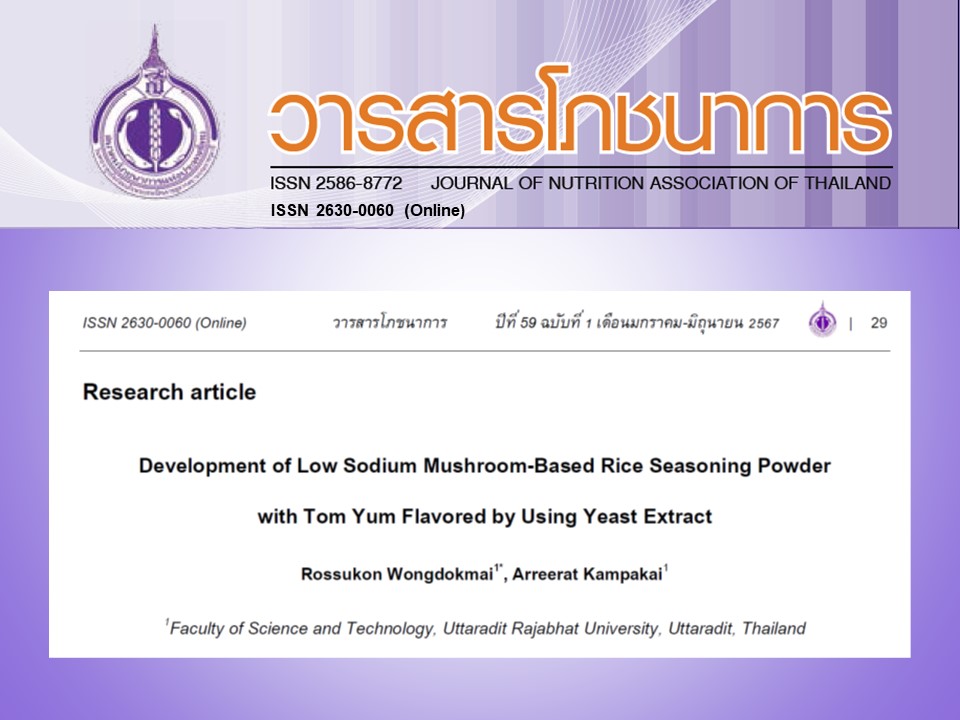Development of Low Sodium Mushroom-Based Rice Seasoning Powder with Tom Yum Flavored by Using Yeast Extract
Keywords:
Sodium reduction, Yeast extract, Mushroom-based rice seasoning powder, Sensory evaluationAbstract
This study aims to investigate sodium reduction using yeast extract in the mushroom-based rice seasoning powder with tom yum flavored. A reduction of sodium chloride from the basic formula by 40%, 50%, and 60% and supplementation with yeast extract at three levels: 0.50%, 0.75%, and 1.00% of the total weight was carried out. These products were subjected to sensory evaluation by 5 trained panelists using a 9-point hedonic scale. Moreover, the study aimed to assess consumer acceptance of the products compared to the basic formula. The evaluation was conducted by 50 untrained panelists using a 5-point hedonic scale. Physical properties and nutrient composition were analyzed using standard procedures. The results indicated that the product with a 40% reduction in sodium and supplemented with yeast extract at levels of 0.50%, 0.75%, and 1.00%, received the highest likability scores (an average of 7.87 to 8.03). These scores indicate a high level of overall preference. The product acceptability was assessed and compared to the basic formula, it was found that the product with a 40% sodium reduction and 0.50% yeast extract supplementation had the highest overall likability scores. The average score of 4.58±0.54 indicated a significantly greater preference compared to the basic formula, falling within the category of high likability. The water activity (aw) and color values of the developed product did not differ compared to those from the basic formula. Additionally, the product contains 4.34% moisture, 66.75% carbohydrate, 15.17% fat, 13.67% protein, and 20.80% dietary fiber. Furthermore, the product contains 994 mg/100g sodium, indicating a 31.41% reduction compared to the basic formula.
References
Jaques DA, Wuerzner G, Ponte B. Sodium intake as a cardiovascular risk factor: a narrative review. Nutrients. 2021;13(9):3177.
Grillo A, Salvi L, Coruzzi P, Salvi P, Parati G. Sodium intake and hypertension. Nutrients. 2019;11(9):1970.
Borrelli S, Provenzano M, Gagliardi I, Michael A, Liberti ME, De Nicola L, et al. Sodium intake and chronic kidney disease. Int J Mol. 2020;21(13):4744.
World Health Organization. Guideline: Sodium intake for adults and children: World Health Organization; 2012.
กรมควบคุมโรค. ยุทธศาสตร์ลดการบริโภคเกลือและโซเดียมในประเทศไทย ปี พ.ศ.2559-2568 2559.
กระทรวงอุตสาหกรรม สำนักงานมาตรฐานผลิตภัณฑ์อุตสาหกรรม. มาตรฐานผลิตภัณฑ์ชุมชน ผงปรุงรสอาหาร มผช. 494/2547.
ลักษณิณ รุ่งตระกูล. ความสัมพันธ์ของการใช้เครื่องปรุงอาหารสำเร็จรูปกับปริมาณโซเดียมในอาหารของ ผู้บริโภคในเขตกรุงเทพมหานคร.: วิทยานิพนธ์ปริญญา วิทยาศาสตรมหาบัณฑิต (สาธารณสุขศาสตร์) สาขาวิชาเอกโภชนวิทยา มหาวิทยาลัยมหิดล; 2552.
Tomé D. Yeast extracts: Nutritional and flavoring food ingredients. ACS Food Sci Tech. 2021;1(4):487-94.
Srisungwan S, Chalermchaiwat P, Suttisunsanee U, Jittinandana S, Chamchan R, Chemthong C, et al. Development of reduced-sodium seasoning powder using yeast extract. Walailak Procedia. 2019;2019(1):IC4IR. 66-IC4IR.
Campagnol PCB, dos Santos BA, Wagner R, Terra NN, Pollonio MAR. The effect of yeast extract addition on quality of fermented sausages at low NaCl content. Meat Sci. 2011;87(3):290-8.
McMacken M, Shah S. A plant-based diet for the prevention and treatment of type 2 diabetes. J Geriatr Cardiol: JGC. 2017;14(5):342.
Kim H, Caulfield LE, Garcia‐Larsen V, Steffen LM, Coresh J, Rebholz CM. Plant‐based diets are associated with a lower risk of incident cardiovascular disease, cardiovascular disease mortality, and all‐cause mortality in a general population of middle‐aged adults. J Am Heart Assoc. 2019;8(16):e012865.
ชุษณา เมฆโหรา. โซเดียมการรับรสเค็มและการปรับลดปริมาณโซเดียมในผลิตภัณฑ์อาหาร. อาหาร. 2565;52(1):16-23.
Tao Z, Yuan H, Liu M, Liu Q, Zhang S, Liu H, et al. Yeast Extract: Characteristics, Production, Applications and Future Perspectives. JMB. 2023;33(2):151.
กระทรวงอุตสาหกรรม สำนักงานมาตรฐานผลิตภัณฑ์อุตสาหกรรม. มาตรฐานผลิตภัณฑ์ชุมชน ผงโรยข้าวจากปลา มผช.1605/2565.
กระทรวงสาธารณสุข สำนักโภชนาการ กรมอนามัย. ปริมาณสารอาหารอ้างอิงที่ควรได้รับประจำวันสำหรับคนไทย พ.ศ. 2563.
จริยา บุญภัทรรักษา. การลดการบริโภคโซเดียมในผู้ป่วยที่มีภาวะหัวใจล้มเหลว. วารสารโภชนบำบัด. 2560;1(25).
Stanley RE, Bower CG, Sullivan GA. Influence of sodium chloride reduction and replacement with potassium chloride based salts on the sensory and physico-chemical characteristics of pork sausage patties. Meat Sci. 2017;133:36-42.
Yang Q, Liu T, Kuklina EV, Flanders WD, Hong Y, Gillespie C, et al. Sodium and potassium intake and mortality among US adults: prospective data from the Third National Health and Nutrition Examination Survey. Arch Intern Med. 2011;171(13):1183-91.

Downloads
Published
How to Cite
Issue
Section
License
Upon acceptance of an article, copyright is belonging to the Nutrition Association of Thailand.


